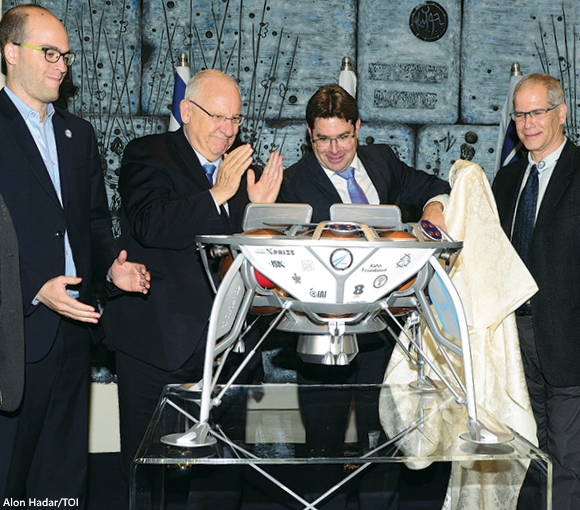 |
| Israeli President Reuven Rivlinlooks on as SpaceIL's GLXP lunar lander prototype is unveiled [Alon Hadar]. |
Abigail Klein Leichman
New Jersey Jewish Standard
Why is a team from the tiniest country in the Middle East joining an international race to the moon?
It’s not just the promise of a Google Lunar XPRIZE of $20 million to the first team (and $5 million to the second team) that lands an unmanned spacecraft on the moon by December 31, 2017, and then moves it 500 meters across the lunar surface as it sends high-definition images and videos back to earth.
The Israelis’ participation has much to do with a cultural passion to accomplish the seemingly impossible. It also is fueled by a desire to make history, inspire Jewish pride, and encourage more young people to pursue careers that will sustain Israel’s leading position in the high-tech world.
 |
| Still image from YouTube video detailing the SpaceIL ballistics. the Israeli team intends to utilize graduated orbital phases to attain increasing apogee in graduated stages, similar to the polar orbit method previously employed by both ESA and the ISRO. The team has chosen the Reiner Gamma swirl and magnetic anomaly north of the lunar equator in Oceanua Procellarum as its eventual landing site. |
“Only global superpowers with billion-dollar space programs — the United States, Russia, and China — have soft-landed a rover on the surface of the moon,” said SpaceIL’s CEO, Dr. Eran Privman, last October, when SpaceIL became the first Google Lunar XPRIZE (GLXP) team to sign a verified launch contract for a privately funded mission to the moon.
On February 17, Yonatan Winetraub — one of three young Israeli engineers who founded the nonprofit organization SpaceIL in 2010 to enter the GLXP competition — will speak about the ambitious project at Rutgers University in New Brunswick.
Read the full and unusually detailed write-up HERE.

2 comments:
Finally! Yes, after years of delay it looks like we are actually getting close to some real GLXP flights. Some people have given up on GLXP altogether, but it may indeed happen, and happen next year. China captivated the world with its lander and rover two years (+) ago, and will fly its sample return mission around the same time that we can expect several attempts on the GLXP, so next year should be an exciting time. People have not lost interest in the Moon despite what some would have us believe.
Oh yes, and Joel, I'm glad you are posting again!
Phil
This time I read many useful tips. I consider that this experts curriculum vitae creator in - sky custom writing com helps everybody. Thanks a lot.
Post a Comment